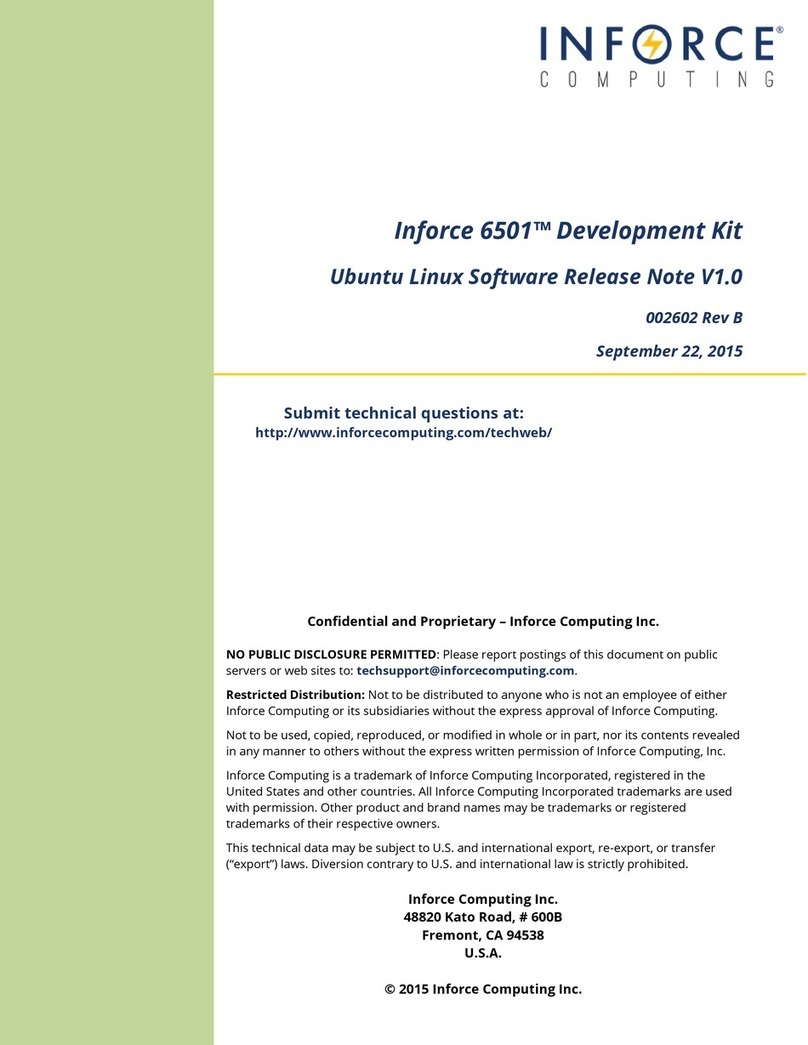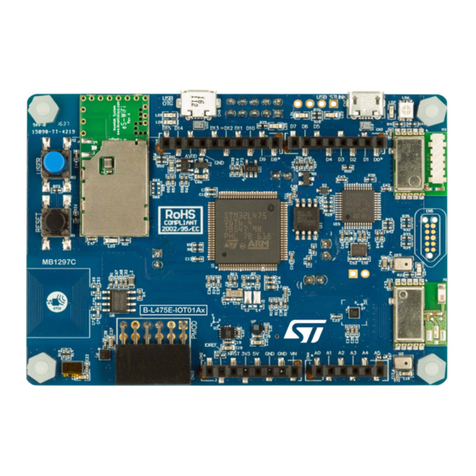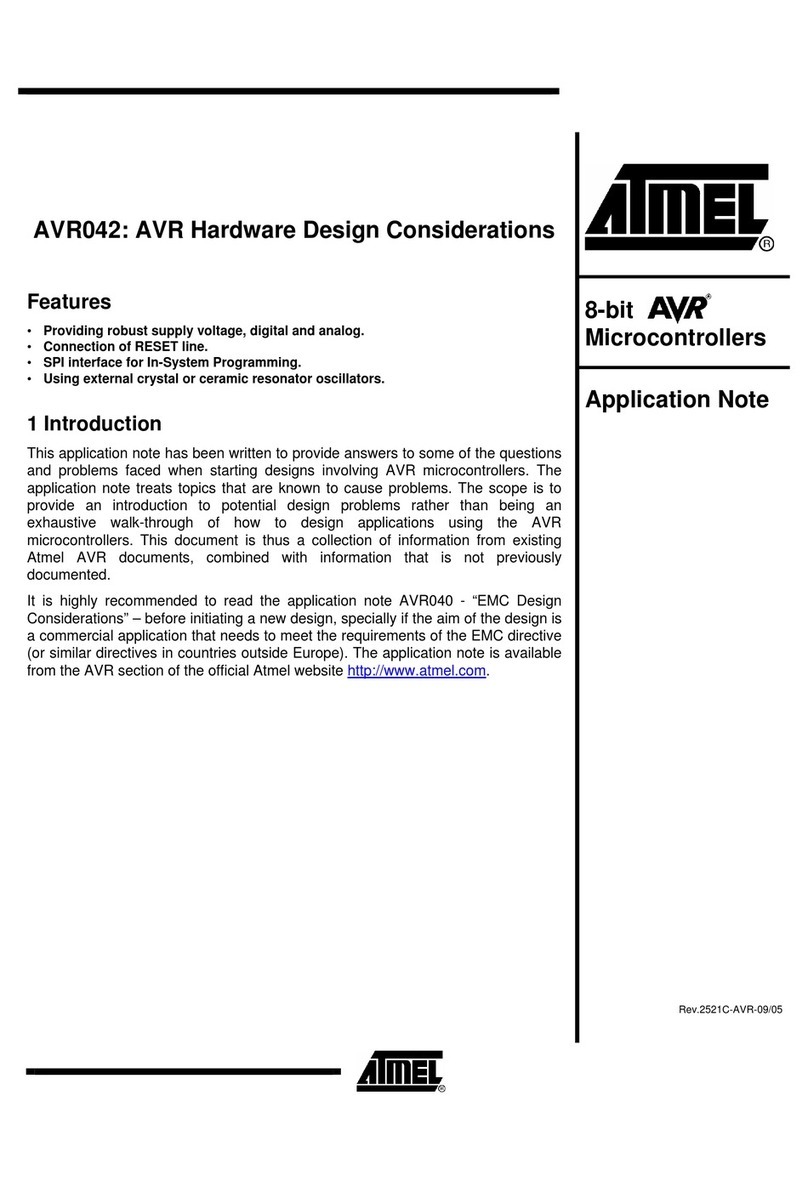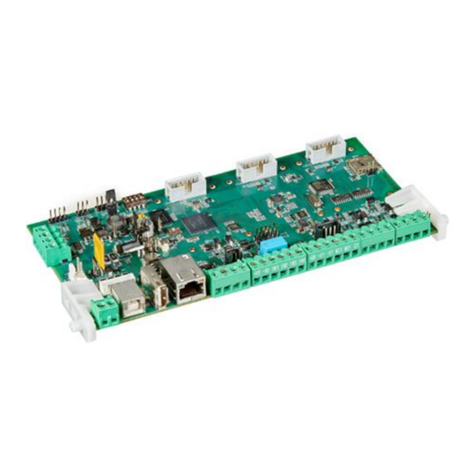Sponsler IT400 User manual

INSTALLATION & OPERATION
MANUAL
IT400
Remote Totalizer & Rate Indicator
Document # MN-IT400-R2c.doc

Liquid Controls
Sponsler, Inc. IT400 Remote Totalizer & Rate Indicator Page:
ii
DOC#: MN-IT400-R2c.doc
Notice
Proprietary Notice
The information contained in this publication is derived in part from proprietary data and trade secrets.
This information has been prepared for the expressed purpose of assisting operating and
maintenance personnel in the efficient use of the instrument described herein. Publication of this
information does not convey any rights to use or reproduce it or to use for any purpose other than in
connection with the installation, operation and maintenance of the equipment described herein.
Copyright 2008
Printed in the USA. All Rights Reserved.
SAFETY INSTRUCTIONS
The following instructions must be observed.
•Every effort has been made to design and manufacture this instrument to be safe for its intended
use. A hazardous situation may occur if this instrument is not used for its intended purpose or is
used incorrectly. Please note operating instructions provided in this manual.
•The instrument must be installed, operated and maintained by personnel who have been properly
trained. Personnel must read and understand this manual prior to installation and operation of the
instrument.
•An auto-resettable fuse internally protects this instrument. To reset the fuse, remove all power
from the unit for one minute.
•The manufacturer assumes no liability for damage caused by incorrect use of the instrument or for
modifications or changes made to the instrument.
Technical Improvements
Liquid Controls Sponsler, Inc. may modify the technical data herein without notice.
Warning:
Do not open the enclosure when an explosive gas atmosphere is present.

Liquid Controls
Sponsler, Inc. IT400 Remote Totalizer & Rate Indicator Page:
iii
DOC#: MN-IT400-R2c.doc
Table of Contents
Description............................................................................................................................................1
CE Declaration of Conformity............................................................................................................1
Specifications ....................................................................................................................................2
Wiring and Hookup Diagrams ...............................................................................................................3
IT400 Operational Overview .................................................................................................................7
Calibration .........................................................................................................................................7
Temperature Compensation..............................................................................................................7
Linearization ......................................................................................................................................7
LCD Display ......................................................................................................................................8
User Controls ....................................................................................................................................9
Non-User interfaces ..........................................................................................................................9
Inputs...............................................................................................................................................11
Backlight..........................................................................................................................................12
Power ..............................................................................................................................................12
Enclosure ........................................................................................................................................13
Menu System ......................................................................................................................................14
Button functions...............................................................................................................................14
Editing numbers ..............................................................................................................................14
Menu descriptions ...........................................................................................................................15
Appendix.............................................................................................................................................23
Appendix 1: Menu Quick Reference................................................................................................24
Appendix 2: Coefficient of Thermal Expansion for Common Fluids.................................................25
Appendix 3: Menu Flow Chart .........................................................................................................26
Appendix 4: Manual Revision History..............................................................................................33

Liquid Contro
ls
Sponsler, Inc. IT400 Remote Totalizer & Rate Indicator Page: 1 DOC#: MN-IT400-R2c.doc
Description
General Unit Operation
The IT400 Remote Totalizer and Rate Indicator is a microcontroller based flow instrument capable of
translating flow information and conditions to the built-in display and various outputs.
Features
•Pulse input supports turbine as well as many other pulse-type flowmeters
•All features/configuration settings are available via field programmability
•Independent rate/total display
•Magnetically operated internal switches maintain enclosure integrity
•Built-in digital multimeter and simulation functions for testing
•2-20 point Linearization available
•Non-resettable “Grand” totalizer
•All outputs are fully opto-isolated (not RS-232)
•RS-232 port available
•Temperature compensation (RTD probe) available
•Backlight and backlight timer for low light display viewing
•Autoranging Rate display (decimal point will shift based on the size of the rate)
•Selectable power modes for customized battery life
•Available Datalogger can capture up to seven process/system values
CE Declaration of Conformity
This is to certify that the listed equipment below conforms to the listed Directive and Product
Standard.
Name of Manufacturer: Liquid Controls Sponsler, Inc. A Unit of IDEX Corporation
2363 Sandifer Boulevard
Westminster, SC 29693 USA
Type of Equipment: Flow Totalizer
Conforming Models: IT400-DC-TRCL-AWX-RFARS2D (and derivatives)
Directive/Product Standard: EMC Directive 89/336/EEC using EN61326
Equipment Type/Environment: Normal Locations
Sponsler Company, Inc.
Date: March 18, 2008
Signature: Burt Anderson
Title: VP Operations

Liquid Contro
ls
Sponsler, Inc. IT400 Remote Totalizer & Rate Indicator Page: 2 DOC#: MN-IT400-R2c.doc
Specifications
Display
•Total
•8 digit 5.40mm high LCD (continuous display)
•Batch total (magnetic reset)
•Grand total (no reset)
•Rate
•5 digit 8.66mm high LCD (continuous display)
•Range over/under limit indication
•Refresh rate: Multiple depending on power
mode (1/16s, 1/8s, 1/4s, 1s, 0.5s)
•Backlighted green w/ LED (magnetically activated
and timed)
•Dual segment low-battery warning
•Maintenance due warning
•Temperature range warning
Power:
•Internal: D Lithium battery
•Battery life: Various: typical per power mode:
1: 1yr, 2: 1yr; 3: 3.6yr; 4: 3yr; 5: 8yr
•External DC: 5 to 48VDC +/- 2 VDC reverse
polarity protected (Max: 12mA w/ backlight)
•Loop: requires 7VDC of loop supply
•Loop powered from the 4-20mA loop input
(non-isolated)
K-Factor range
•Pulses per gallon: 0.0000001 to 999999
Signal Input (flow)
•Frequency: 0-3000Hz
•Impedance: 10k ohms
•Magnetic
•Sensitivity: 50mV-36V (field adjustable) sine
or square wave
•Modulated carrier
•Carrier frequency 50kHz (requires external
power or loop power)
Compensation Input
•Temperature - RTD
•Two wire 10k ohm
•Coefficient of Thermal Expansion method
•Frequency
•Linearization table 2 to 20 points
Engineering Unit Conversions
•Pre-programmed units: Gallons, Liters, Ft
3
, M
3
,
Pounds, BBL, KG (custom weight available)
•Custom units available with given units/gallon
•Rate and Total may have separate unit displays
Decimal Locations
•Total: Two places (and x10, x100)
•Rate: Three places (and x10, x100), autorange
Time Base
•Rates can be displayed in units per second,
minute, hour, day, and custom (in seconds)
Outputs
•Factored Pulse (Max: 150mA, 30VDC, 150mW)
•Opto-isolated open collector output
•Frequency or fixed pulse width (1, 2, 5, 10,
50, 100, & custom ms) output setting
•Output pulse Divider: 1, 2, 5, 10, 50, 100,
1000, & custom
•Alarm (Max: 150mA, 30VDC, 150mW)
•Programmable opto-isolated open collector
output
•Can be used to control totalization
(Max values at 25°C. Max combined Pulse/Alarm
output power: 190mW @ 25°C, 32mW @) 65°C)
•Rate (4-20mA)
•Factored rate to current loop output
•Programmable low and high
•Fully isolated (unless loop powered)
•Loop Voltage limit: 7-36VDC
Accuracy
•Display: ±0.01% reading (rate) or ± 1 count (total)
•Analog output: ±0.025% of fs @20°C
•Digital output: ±1 count
Environmental
•Operating: -30 to 65°C (-22 to 150°F)
•Storage: -40 to 85°C (-40 to 185°F)
Enclosure
•Explosion Proof Aluminum
•FM Approved, CSA Certified
•Class I, Division1, Groups B, C, & D
•Class II, Division 1, Groups E, F, & G
•NEMA 4X, IP66
•All openings ¾” FNPT
•Weight: 2.5lbs.
•Mount: Directly on flowmeter or Wall mount
Compliance
•CE 0575
•ATEX Ex II 2 G Ex d IIC T6 Gb (X and WX
enclosure types only)
•DNV-2008-OSL-ATEX-19241X
Communications
•RS-232
Datalogger
•Up to four triggers (including timer)
•Up to seven system values
•Real-time clock
•RS-232 or Internal SD/MMC Flash media card
Other features
•EEPROM setup storage (>100 year retention)
•All features/settings are field programmable.
Convenient number input via 0-9 rotary switch and
two pushbuttons

Liquid Contro
ls
Sponsler, Inc. IT400 Remote Totalizer & Rate Indicator Page: 3 DOC#: MN-IT400-R2c.doc
Wiring and Hookup Diagrams
The IT400 has many connections all made through the bottom/mounting board. It is
recommended to remove the battery when connecting wires to the connectors and when plugging
the connectors into their sockets.
Wiring
In order to maintain the rated CE marking, the following practices must be followed:
•All wires connected to the IT400 must be shielded (exception: SI supplied signal cable).
oAll shields must be connected to one of the internal mounting screws to achieve their
ground connection.
oIt is recommended that the non-IT400 end of these shields is left unconnected. This
will help avoid ground loops and unexpected behavior.
oIt is recommended that only one spade type terminal be used on each of the screws.
Care should be taken to avoid shorting any spade with other circuitry on the mounting
board. If a longer screw is needed to attach the shielding spade, then the screw
must be chosen to ensure at least one extra thread of space behind the screw. The
hole depth is approximately 0.250 inches.
oShields should not cover more than one pair of signal wires at a time.
•The IT400’s chassis must be connected to an earth ground via the screw attached to the
outside of the unit. At least a 12 AWG preferably green wire is recommended.
•All connections are to be made to the unit via rigid conduit.
•All connected wires must not exceed 98’ length.
•DC powered devices requiring the CE marking must be 4-20mA loop powered.
If no wires are required for a particular installation; the only requirement is the chassis ground
connection.
Battery Removal and Installation
Battery Replacement: The internal battery may only be replaced with one of two batteries:
- E8010 from Liquid Controls Sponsler, Inc.
- TL-5930/F from Tadiran Batteries, Ltd.
Battery Removal: Unscrew the IT400 cover, press and hold the menu button until the option to
reset the totalizer appears, the totalizer/grand totalizer/service timer will be saved to memory.
Using two fingers inserted in the slots on the top and bottom of the main board overlay, gently rock
the board top to bottom while pulling straight out. If this is done too quickly or unevenly, the main
board will be damaged. After the main board is removed, the battery is accessible by opening the
hook-loop strap. Once the battery is loose, the battery clip is removed by compressing the locking
tab on the connector (locking tab is on the top of the connector {J3}) and pulling it out.
Battery installation: Reverse the process for installation. Ensure the battery connector key is in the
proper orientation prior to insertion.

Liquid Controls
Sponsler, Inc. IT400 Remote Totalizer & Rate Indicator Page: 4 DOC#: MN-IT400-R2c.doc
Diagrams:
Figure 1 IT400 Connections

Liquid Controls
Sponsler, Inc. IT400 Remote Totalizer & Rate Indicator Page: 5 DOC#: MN-IT400-R2c.doc
TB5
TB6
J1
J3
TB2
TB3
TB4
JP3
TB5
1234
1234
1
1
2
1
21
12
3
2
1
TB1
!
"#$%&%'()"*%(#+',-#.#"&
/
!
"#$%&%'()"*%(#+',-#.#"&
/
Figure 2 IT400 Board Stack Assembly and Battery Removal

Liquid Controls
Sponsler, Inc. IT400 Remote Totalizer & Rate Indicator Page: 6 DOC#: MN-IT400-R2c.doc
!
"#$%&%'()"*%(#+',-#.#"&
/
Figure 3 Meter Mounting and Dimensional

Liquid Controls
Sponsler, Inc. IT400 Remote Totalizer & Rate Indicator Page: 7 DOC#: MN-IT400-R2c.doc
IT400 Operational Overview
The IT400 flowmeter system will perform the necessary calculations to provide the user with an
optional temperature compensated and optional linearized output of the following values:
•Rate
•Total
•Grand total
•Errors/warnings
•Various outputs
Calibration
Calibration of the IT400 is accomplished using either a linear K-Factor (pulses per gallon) or a
linearized K-Factor linearization table (when the linearizer is enabled). Independent unit conversion
factors and decimal points are available for the rate and total displays. Calibration and configuration
data are stored in an onboard EEPROM for permanent storage. Calibration of the IT400’s reference
circuitry is factory set and is not user accessible. Calibration of the IT400’s reference circuitry should
be performed by factory trained service personnel.
Temperature Compensation
The temperature compensator utilizes a platinum RTD to detect the process temperature. Process
temperature is used in conjunction with the reference temperature and Coefficient of Thermal
Expansion of the measured liquid (menu items) to adjust the rate and total values. When the
temperature compensation is enabled, the temperature warning annunciator (thermometer on the
LCD) will indicate when the process temperature is out of a programmable range. Optionally, an
alarm output as well as a totalizer inhibit function can also be tied to this temperature warning.
Various Coefficient of Thermal Expansions and their reference temperatures can be found in the
appendix. The temperature circuit and associated algorithm, when enabled, increase the IT400
current consumption from the power source and diminish battery life if running solely from the battery.
A programmable delay function has been provided in order to minimize the impact of the temperature
sampling on the battery life. The delay feature specifies the number of seconds between temperature
value samples. The higher the delay, the longer the battery will last.
Linearization
The linearizer utilizes a linear interpolation algorithm to calculate the rate and total based on a set of
calibration data points programmed by the user. The linearizer has21 points, the first point (lowest) is
automatically set at zero hertz, the remaining 2 to 20 are user programmable. The linearizer table
must have at least two data points in addition to the first (fixed) point and must be ascending in
frequency from the first point to the last. To have fewer than 20 points in the linearizer table, after the
last desired linearization point add one additional point and set the frequency at zero. Zero is an
invalid frequency; this will indicate the end of the table. The IT400 will not allow frequencies to be
entered out numerical order. Frequencies between zero and the first programmed point will use the
K-Factor of the first programmed point.

Liquid Controls
Sponsler, Inc. IT400 Remote Totalizer & Rate Indicator Page: 8 DOC#: MN-IT400-R2c.doc
LCD Display
The LCD display has three main areas: The 8 digit totalizer,
5 digit rate indicator, and the annunciators.
•The 8-digit totalizer shows the total number of units
of volume through put of the flowmeter since the last
time the totalizer was reset. The totalizer is
resettable by 2 methods, via a magnetic reed switch
in the lower left side of the unit and by menu. The
grand total is displayed as long as a magnet is
placed near the top of the face of the unit. The word
"GRAND" indicates the displayed value is the grand
total. Grand should be activated prior to battery
replacement to save total/grand total values to non-
volatile memory. Engineering unit annunciators
display the units and decimal place selected to compute total and grand total values. The
grand totalizer uses the same engineering unit as programmed for the totalizer.
•The 5-digit rate display shows the rate of the flowmeter throughput. If the rate exceeds the
high flow warning setpoint, "" is displayed. ““ is displayed when the rate is less than
the low flow warning setpoint. The warning is displayed until flowrate within these setpoints
resumes. The totalizer is not affected by this warning unless programmed to inhibit totalizer
when out of range. The range limits are established by the flow warning setpoints (Warning
menu) in the menu system. Indicators on the display also show the engineering units of
volume, time and decimal place used to compute the rate value.
Note: When the Grand Total magnetic reed switch is activated (and
GRAND
is displayed on the
screen), the rate display will display the current rate regardless of the range limits. This is
helpful when troubleshooting flow condition problems when the low rate setpoint is set above
zero.
•Refresh rate of the display of the unit happens at pre-determined intervals depending on the
selected power mode (see “Power”). Once the power mode is programmed (in the menu), the
refresh rate is fixed. This prevents a low refresh rate from being automatically selected which
could cause measurement delay.
•Other display annunciators. These are warning indicators and do not inhibit the operation of
the unit (unless explicitly enabled to do so by the alarm option). These indicators may
however indicate the condition causing an inaccurate reporting of rate or total information.
oWrench – The service annunciator is user programmable to a specific amount of
“turbine hours” (active flowmeter hours).
oThermometer – The thermometer annunciator is displayed continuously any time the
temperature compensator is enabled and the process temperature is out of range.
oBattery – The battery annunciator is composed of two segments. The segments
indicate the level of the battery charge, like an automotive gas gauge.
Two segments – The battery is within normal operating voltage range.
One segment – A replacement battery should be acquired and installed. This will
also cause high temperature range on the temperature circuit to be reduced.
8 digit
Total
5 digit
Rate

Liquid Controls
Sponsler, Inc. IT400 Remote Totalizer & Rate Indicator Page: 9 DOC#: MN-IT400-R2c.doc
No segments – The battery must be replaced to guarantee accurate reporting.
User Controls
There are two main groups of user controls, internal and external. The internal controls are only
accessible when the enclosure cover is removed. The external controls are magnetically accessed
by strategic placement of a magnet along the outside of the unit.
•Internal
oMenu / Enter Button – This button is used primarily within the menu system. Press this
button at any time during RUN mode to enter the menu system. Note: the higher the
power mode, the longer the button will need to be held down for it to trigger the menu
system.
oSelect / Digit Button – This button is also used primarily within the menu system.
However, when the temperature compensation option is purchased and enabled,
pressing this button while in RUN mode causes the 5-digit display to indicate the
current process temperature in degrees Fahrenheit.
oNumber Dial – The number dial is only used while selecting values or editing numbers
while in the menu system. The number dial is disabled in RUN mode.
•External
oMagnetic Switches – There are three magnetically activated reed switches located
around the edge of the IT400 (indicated on the front panel with yellow text). These
switches allow external activation of the following functions:
Grand – The following actions are taken when the grand reed switch is activated:
The total display will indicate the value of the grand totalizer.
The rate display will indicate the current rate regardless of any out of range
warning conditions.
The GRAND annunciator will indicate.
The IT400 will store the values of the grand totalizer, the totalizer, and the
elapsed service time to non-volatile memory. This is useful if the IT400 is to
be removed from service (replace battery, recalibrate, etc).
Light – When activated, the backlight timer will be engaged according to the chart in
the Backlight section.
Reset – When activated, the main totalizer will be reset.
Note: The internal user controls are described in more detail in the Menu section.
Non-User interfaces
Non-user interfaces are those that are wired to external devices. 4-20mA rate output and open
collector pulse output are standard, open collector alarm output, RS-232, datalogger, and real time
clock interfaces are optional.
•4-20mA rate output is a linear representation of flow rate between the programmed low and
high setpoints.
Example: A flowmeter has a calibrated range of 10 to 100gpm, the desired low and
high setpoints of the 4-20mA output are 10 and 100 respectively. Using these values,
the IT400 will calculate and output the proper current reading for a given flowrate.

Liquid Controls
Sponsler, Inc. IT400 Remote Totalizer & Rate Indicator Page: 10 DOC#: MN-IT400-R2c.doc
Given a flow rate of 25gpm, the current loop reading will be 6.667mA. The output
engineering units are the same as for the rate display.
Note: For loop powered operation, refer to the Power section.
Note: The IT400 requires 7VDC of the loop supply.
•Pulse output is an open collector design. A pull up resistor is required for interface with most
systems. An output pulse occurs with each increment of the totalizer if a pulse output divider of
1 has been programmed. For programmed pulse divider values other than 1 the output pulse
will occur at the divided value. Functions for a frequency output, pulse width, and pulse output
divider are programmable. When the frequency output is not selected, pulses are output in
bursts at each refresh.
Example: The totalizer increments 15 pulses (over the last refresh time) and the pulse
output divider is 5. The number of output pulses that will be generated will be 3.
Note: If the output pulse width programmed exceeds the time required to output the proper
number of output pulses an will be displayed in the left-most character of the total display.
The IT400 will output as many pulses as time permits at the programmed pulse width.
Example: At a maximum flow of 900gpm the proper number of output pulses is 15 per
second, but the pulse width is programmed to 100ms and the pulse divider to 1. The 15
pulses would take 1.5 seconds (15x100ms); only 10 pulses would be outputted. Either
the pulse width must be reduced or if acceptable the divider increased.
Guideline: calculate the maximum output pulse width:
Maximum pulse width = 1/(output pulses per second/output pulse divider)
Using the example above: 1/(15/1) = 66.6ms is maximum pulse width.
•Alarm output is an open collector output that can be used to externally indicate the presence
of several out of range conditions. These conditions include: temperature, flow rate, and
battery level. The ranges of temperature and flow rate are edited in their respective sections of
the Menu system. The Battery low level is factory set. Any Alarm condition of the enabled
alarms will activate the alarm output. Identical to the output pulse, a pull up resistor is required
to interface with most systems.
•RS-232 interface allows calculated values of the unit to be viewed upon request. To use this
interface, a serial device (computer or datalogger) is used to poll the IT400 by sending one of
the listed letters (the letter by itself) to the serial port. No carriage return is necessary. The
IT400 will reply with the requested data and a CR+LF. The BAUD rate is fixed at 9600 baud
8N1. Currently, the datalogger data can only be captured via the RS-232 port. The functions
available on this interface are:
R – Rate Z – Reset Totalizer K – K Factor
T – Total Q – Total CF L – Linearizer Table
G – Grand total W – Rate CF F – Process Temperature (Deg F)
C – Capture Data (Trigger a datalogger event)
Note: Using the RS-232 interface when loop powered will cause errors in the loop reading.

Liquid Controls
Sponsler, Inc. IT400 Remote Totalizer & Rate Indicator Page: 11 DOC#: MN-IT400-R2c.doc
•Datalogger allows various working data to be captured based on several different triggers. To
use this interface, a serial input device (computer or printer) is used to capture the data from
the IT400. Refer to the menu section of the manual to see the data that can be captured and
what triggers are available. Each line of data is terminated by a CR+LF combination (0x0D
and 0x0A). There are two data format outputs available, DB and non-DB:
DB Format: The DB format lists the enabled data in the following order: Time, Total, Rate,
Grand Total, Temperature, K-Factor, and Warnings. Units are the same as displayed on the
LCD. The time listed is the “UNIX” time or the number of seconds from the UNIX Epoch time
(Jan 1, 1970, 0:00:00 GMT). No Daylight Savings Time (DST) or time zone adjustment is
made. Example:
2147498935, 1073, 919.532, 37211, 32.2, 58.71818, 0
2147498937, 1104, 919.687, 37242, 32.2, 58.71818, 0
2147498939, 1135, 919.506, 37273, 32.2, 58.71818, 0
2147498941, 1165, 919.557, 37303, 32.2, 58.71818, 0
2147498943, 1196, 919.609, 37334, 32.2, 58.71818, 0
2147498945, 1227, 919.385, 37365, 32.0, 58.72917, 0
Non-DB Format: The non-DB format lists the enabled data in the same order as in the DB
format, but will be listed one item per line. In addition, this format shows the engineering units
of each value. The date/time is adjusted for local time zone as set in the menu. DST is not
included as this would allow duplicate time stamps. Example:
Date/Time: Mon Jan 18 2038 13:14:54 GMT-5:00:00
Total: 98 G
Grand Total: 36235 G
Temperature: 32.0F
K-Factor: 58.72917 P/G
Warnings: 0:
•Real-time clock maintains the current date and time for use with the datalogger. Each
datalog event is preceded with the current date and time. Time is calculated by maintaining
the number of seconds since the UNIX Epoch time (Jan 1, 1970, 0:00:00 GMT). The real-time
clock does not increment unless the IT400 is powered (either by DC-in, battery, or 4-20mA).
When the battery is replaced, the internal clock will be slow by the amount of time between the
time the menu is entered (just prior to removing the battery) and the time the IT400 is again
powered (after the battery replacement). The real-time clock can be set in the menu system
and is only available when the datalogger option is purchased.
Inputs
The IT400 has four inputs: RS-232 interface, user interface, temperature, and input signal.
•RS-232 interface is described above.
•User interface is described above.
•Temperature input is a standard 2-wire platinum RTD temperature probe (0.385 TCR). The
temperature probe is typically mounted within a few inches downstream of the attached
flowmeter. The temperature input will increase the drain rate on the battery when the IT400 is
battery powered. The temperature input is ignored if the temperature compensator is disabled.

Liquid Controls
Sponsler, Inc. IT400 Remote Totalizer & Rate Indicator Page: 12 DOC#: MN-IT400-R2c.doc
•Signal input from practically any frequency generating device producing a sinusoidal signal, a
square wave pulse or can be connected to a modulated carrier pickup coil.
Sinusoidal signal: low amplitude crossing signal that doesn’t exceed the IT400’s input
specification. This signal can come directly from the pickup coil sensing rotation of the
attached Sponsler, Inc. turbine flowmeter or other flowmeter device.
Square signal: any zero referenced pulse that doesn’t exceed the IT400’s input
specification.
Modulated carrier: derived by modulating a carrier signal of the pickup coil caused by
the change in impedance resulting from the rotor blades passing in proximity to the coil.
This is an inductive coil therefore there is no drag on the rotor. MC coil operation is
factory enabled only. MC coil operation requires DC or loop power.
Note: SW5-3 must be “On” for MC coil operation when externally DC powered.
Backlight
The backlight is controlled by a combination of system parameters. The following table lists the
operation of the backlight and how it is controlled by these various system parameters:
DC
Powered
4-20mA
Powered*
Battery
Condition
value
Backlight
in
Backlight
in Menu
Yes Don’t Care Don’t Care Non-Zero ON ON
No No Good Non-Zero Timer ON
No No Low Don’t Care Manual OFF
No Yes** Good Non-Zero Timer ON
No Yes Don’t Care Don’t Care Manual OFF
Don’t Care Don’t Care Don’t Care
Manual OFF
Don’t Care No Good ON ON
* SW5-1, SW5-2, & SW5-3 “On”.
** SW5-3 “Off” (4-20mA loop to power modulated input and battery to power main circuit).
*** If the timer is set to , the battery will last about two months when not DC powered.
The front panel magnetic reed switch activates the backlight regardless of anything (as long as power
is applied). Backlight activation may increment one additional input pulse and will cause 4-20mA
errors.
Power
The IT400 may be powered externally by any 5-48VDC source, 4-20mA loop, internally by battery, or
by a combination of these. Power consumption is affected by programmed options, input signal
frequency, and the programmed power mode.
•External Power
oDC: 5-48VDC
o4-20mA Loop: used to power the IT400 or just the modulated carrier circuit (which
requires more voltage than is available from the battery). The IT400 requires 7VDC of
the loop supply.

Liquid Controls
Sponsler, Inc. IT400 Remote Totalizer & Rate Indicator Page: 13 DOC#: MN-IT400-R2c.doc
•Internal Battery functions either as a primary power source or as a backup to either of the
external power sources. Battery life estimates are in the Power Mode chart below and are
affected by the options enabled. The battery may be replaced at any time with the only side
effect being a loss of normal operation (all calibration and configuration information is
maintained). Total, Grand Total, and service hours may be saved at any time by activating the
Grand Total display or by entering the menu system. Upon system startup, the saved values
will be retrieved.
External
DC
Loop
Isolation
Battery
Powered
SW5-1
SW5-2
SW5-3
Main
IT400
Power
Modulated
Carrier
Power
Yes Yes* No Off Off On External External
No No** No On On On Loop Loop
No No** Yes On On Off Battery Loop
*For External power, the loop isolation switches SW5-1, 2 must be “Off” (isolated).
** Loop powered operation; the loop isolation switches SW5-1, 2 must be “On” (non-isolated).
•Power Mode:controls the refresh rate of both the display and outputs of the IT400 and is a
user selectable menu item. Refresh times and approximate battery life are in the following
table:
Mode
Refresh Input frequency
Approximate
Battery (years)
1 16 refreshes/s 0
500
2 8 refreshes/s 0
500
3 4 refreshes/s 0 6.5
500 3.2
4 1 refreshes/s 0
500
5 2s/refresh 0
500
*Battery life calculations are worst case based on continuous flow, enabled linearizer,
temperature compensator, 4-20mA output, and pulse output.
Enclosure
The IT400 is contained in an explosion proof enclosure. This enclosure is typically meter mounted
via a union or a temperature extension (consult factory for lengths and applications). There is
typically a short cable (4 feet) that connects the IT400 to an external temperature probe (a few inches
downstream). Rigid conduit is recommended for this connection to maintain the explosion proof
rating of the enclosure and to maintain CE marking.

Liquid Controls
Sponsler, Inc. IT400 Remote Totalizer & Rate Indicator Page: 14 DOC#: MN-IT400-R2c.doc
Menu System
The IT400’s menu system is designed to allow a simple means of entering all of the data required for
the system to perform its calculations. This section steps through the menu system and provides a
description of each item. To enter the menu system, simply press Menu.
Button functions
Menu / Enter – The menu button advances through the menu system. When editing values, this
button provides the “enter” function. Note: The menu may be exited while viewing any main menu
item by pressing and holding Menu, then pressing and holding Select, then releasing Menu, next
releasing Select.
Select / Digit – The select button is used to change values and edit numbers. To edit a displayed
number, Select is pressed to allow editing. When editing numbers, each press of Digit shifts right
the digit to be edited. When selecting between two values, Select is used (this includes /,
/, and /)
Number – The number dial is used to set the current displayed item to a specific value. When editing
numbers, the flashing number will change according to the number dial. When editing decimal
placement of a number, the decimal point will change according to the number dial.
Editing numbers
Some menu items require the editing of a number. All three controls are used to edit the number.
Here is a short example of editing the low temperature warning set point:
1. Number to be edited is displayed:
2. Press Select to edit the number.
3. If the number can be positive or negative, press Select to toggle between
positive () and negative ().
4. Press Enter to accept the desired sign.
5. Next, the actual number can be edited. Numbers are edited
from left to right. The digit that is currently being edited will
flash. Use the Number dial to change the flashing number to
the desired value. If no change is needed, do not move the Number dial.
6. Press Digit to move the edit focus to the next digit. Repeat these steps as
necessary to edit all the digits in the number.
7. Press Enter to accept the changes to the number.
8. If the number can have a decimal, the current decimal location will flash. Use
the Number dial to change the flashing decimal to the desired location. If no change is needed,
do not move the Number dial.
9. Press Enter to accept the decimal location.
10.In most cases, an opportunity to re-edit the number is presented.
.
!
.
!

Liquid Controls
Sponsler, Inc. IT400 Remote Totalizer & Rate Indicator Page: 15 DOC#: MN-IT400-R2c.doc
Menu descriptions
The menu is composed of a list of editable items which control the operation of the IT400. This is a
listing of all of the menu items. The IT400 reverts to the Run Mode if no user input is detected within
30 seconds while viewing any of the following top level menu items.
1. Reset Totalizer
Resets the totalizer without using an external magnet. If the totalizer reset is set to
, the subsequent submenu is not displayed.
1.1 Reset Totalizer Done
This is an informational message that indicates that the main totalizer has been
reset.
2. Temperature Compensation Enable
Displayed only if purchased as an option. Temperature compensation can be
enabled or disabled. If compensation is "#", the next two sub-menus are
skipped.
2.1 Reference Temperature
Temperature at which the Coefficient of Thermal Expansion is referenced. The
temperature units are degrees Fahrenheit and must match the Coefficient of
Thermal Expansion used in the next item (and is listed in the Appendix).
2.2 Coefficient of Thermal Expansion
The Coefficient of Thermal Expansion for select fluids can be found in the
Appendix.
3. Linear Interpolation Enable
Displayed only if purchased as an option. Linear interpolation can be enabled or
disabled. If linearization is "", the next three sub-menus are skipped.
3.1 Linear Interpolation Table Edit
Permits the editing of the linearizer table and is only set if the linearizer has been
enabled. If set to , the linearizer table will not be edited and the menu system
jumps to menu 4 (K-Factor) below. If the table is to be edited, the menu will step through the list of
points in the order of frequency then K factor. The frequency values must be ascending starting with
the first point being the lowest.
Note: To enter a table of fewer than 20 points in the linearizer table, after the last desired linearization
point add one additional point and set the frequency to zero. Example: For 15 point linearization, set
the frequency for point 16 to zero.
Note: The table must have at least two points.
$
%&
.
'%
.
((
$%
"
'"

Liquid Controls
Sponsler, Inc. IT400 Remote Totalizer & Rate Indicator Page: 16 DOC#: MN-IT400-R2c.doc
3.2 Frequency Input
Permits setting of the frequency of a given run in the linearizer. The number listed
on the display indicates which point in the table is being edited. Frequencies must
be in ascending order (point 1 is the lowest frequency). When the frequency is set,
press Enter to accept.
Note: If a frequency point is entered that is not ascending, the device will restore the original value
and return to the frequency for that point.
3.3 K-Factor Input
Allows the setting of the K-Factor of a given point in the linearizer. The number
listed on the display indicates which point in the table is being edited. When the K-
Factor is set, press Enter to accept.
Note: If the table was edited, upon accepting the last K-Factor, the menu will return to menu 3.1
Linear Interpolation Table Edit.
Note: The table edit may be exited while viewing any K-Factor by pressing and holding Menu, then
pressing and holding Select, then releasing Menu, then releasing Select.
4. K-Factor
Only available if the linearizer is "#". The K-Factor is the non-linearized
base meter factor and is always in pulses per gallon. Both total and rate displays
use this K-factor in their base conversion.
5. Totalizer Units
Set by turning the Number dial to the desired position. The dial positions allow
several standard conversions as well as three customizable settings. The
conversion (from gallons) of each position is listed in the upper display. The customizable settings
are LBS, KG, and {blank}. For each of these engineering units, the system allows a customized “per
gallon” conversion to be entered. The {blank} item is for engineering units that are not included in the
standard list. Example: To display pounds of liquid nitrogen, (#2) is selected with the dial and
the value is edited to read 6.745 (6.745 pounds of LN2 per gallon).
6. Totalizer Decimal Place
Set by turning the Number dial to the desired position. If no decimal is shown, the
decimal is assumed one place to the right of the least significant digit.
7. Ratemeter Units
Set by turning the Number dial to the desired position. The dial positions allow
several standard conversions as well as three customizable settings. The
conversion (from gallons) of each position is listed in the upper display. The customizable settings
are LBS, KG, and {blank}. For each of these engineering units, the system allows a customized “per
gallon” conversion to be entered. The {blank} item is for engineering units that are not included in the
standard list. Example: To display pounds of liquid nitrogen, (#2) is selected with the number
dial and the number is edited to read 6.745 (6.745 pounds of LN2 per gallon).
(
.
)(
.
)*(
*
(
.
&
.
)*
(
.

Liquid Controls
Sponsler, Inc. IT400 Remote Totalizer & Rate Indicator Page: 17 DOC#: MN-IT400-R2c.doc
8. Ratemeter Decimal Place
Set by turning the Number dial to the desired position. If no decimal is shown, the
decimal is assumed one place to the right of the least significant digit. There is one
special setting named +'. The autorange setting allows the ratemeter
display to self adjust the decimal point based on the size of the number to be displayed. Example:
Ratemeter decimal set to +'. If the rate is 12.873 GPM, then (,.-. will be displayed. If the
rate increases to 128.73 GPM, then (,-.. will be displayed.
9. Rate Time Base
The time the ratemeter is based on in seconds. The Number dial positions allow
several standard time bases as well as one customizable setting. The conversion
(in seconds) of each position is listed in the upper display. The customizable setting is indicated by
the absence of any time annunciator at the bottom of the display. The {blank} item is for units that are
not included in the standard list. Example: To display the rate in units per week, the customized
number would be edited to read &/-
.
and no annunciator is displayed.
10. 4-20mA Output
The 4-20mA analog output is enabled or disabled in this menu. If the 4-20mA
output is "", the next two sub-menu items are skipped.
10.1 4-20mA Output Low Setting
Used by the 4-20mA output as the low setpoint. Edit the number to read the
desired low flowrate setting. The setpoint engineering units are the same as the
ratemeter engineering units.
10.2 4-20mA Output High Setting
Used by the 4-20mA output as the high setpoint. Edit the number to read the
desired high flowrate setting. The setpoint engineering units are the same as the
ratemeter engineering units.
11. Pulse Output Enable
The pulse output is enabled or disabled in this menu. If the pulse output is
disabled, the next two sub-menu items are skipped.
11.1 Pulse Output - Pulse Width
The pulse width of the pulse output is set by turning the Number dial to the desired
position. The dial positions allow several standard pulse widths as well as one
customizable setting. The selected pulse width in milliseconds is listed in the upper display. There is
one special setting named %'0+*. The frequency setting allows the pulse output to auto adjust
the pulse width based on the number of pulses to be outputted per second. Example: Pulse width
set to %'0+*. If the totalizer is counting to 14 every second, then the output pulse width will be
71.428ms. If the totalizer is now counting to 55 every second, then the output pulse width will auto
*
&
.
!
/,
.
+
11111
.
+2
,
Table of contents
Popular Microcontroller manuals by other brands
Freescale Semiconductor
Freescale Semiconductor MC9S12XHY Series Reference manual
NXP Semiconductors
NXP Semiconductors QN9080 quick start guide
Silicon Laboratories
Silicon Laboratories Thunderboard Sense 2 Get started
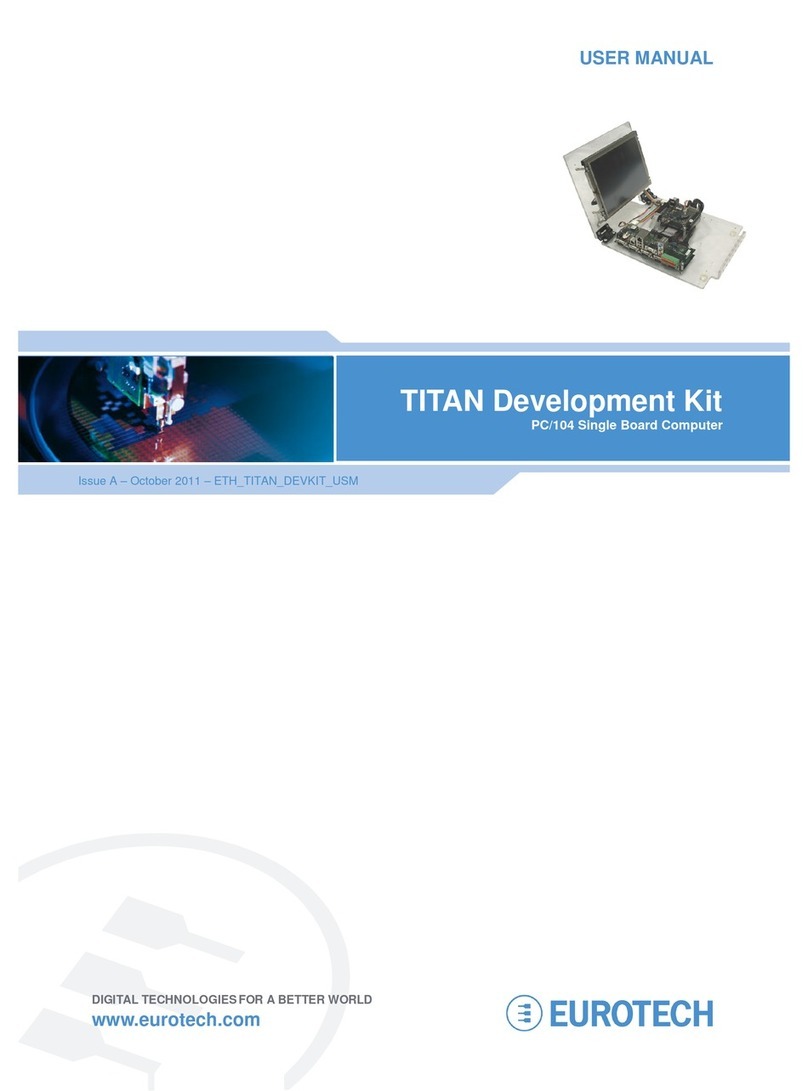
Eurotech
Eurotech Titan user manual
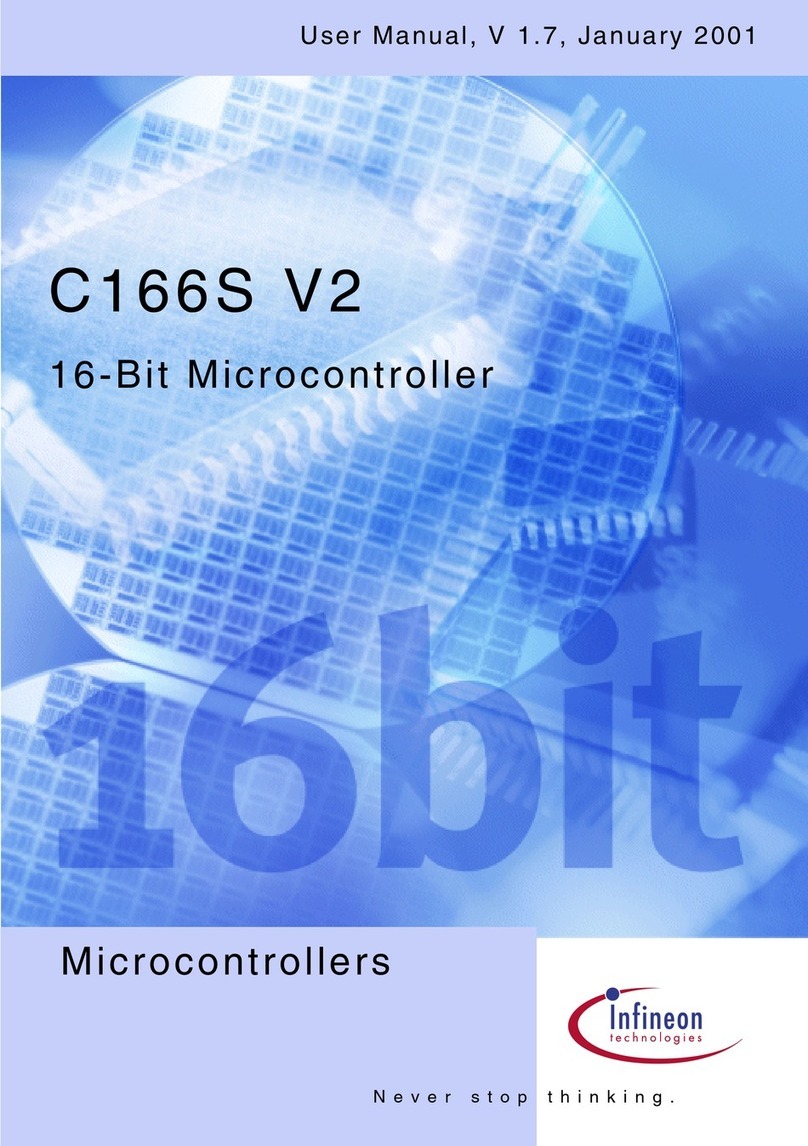
Infineon Technologies
Infineon Technologies C166S V2 user manual
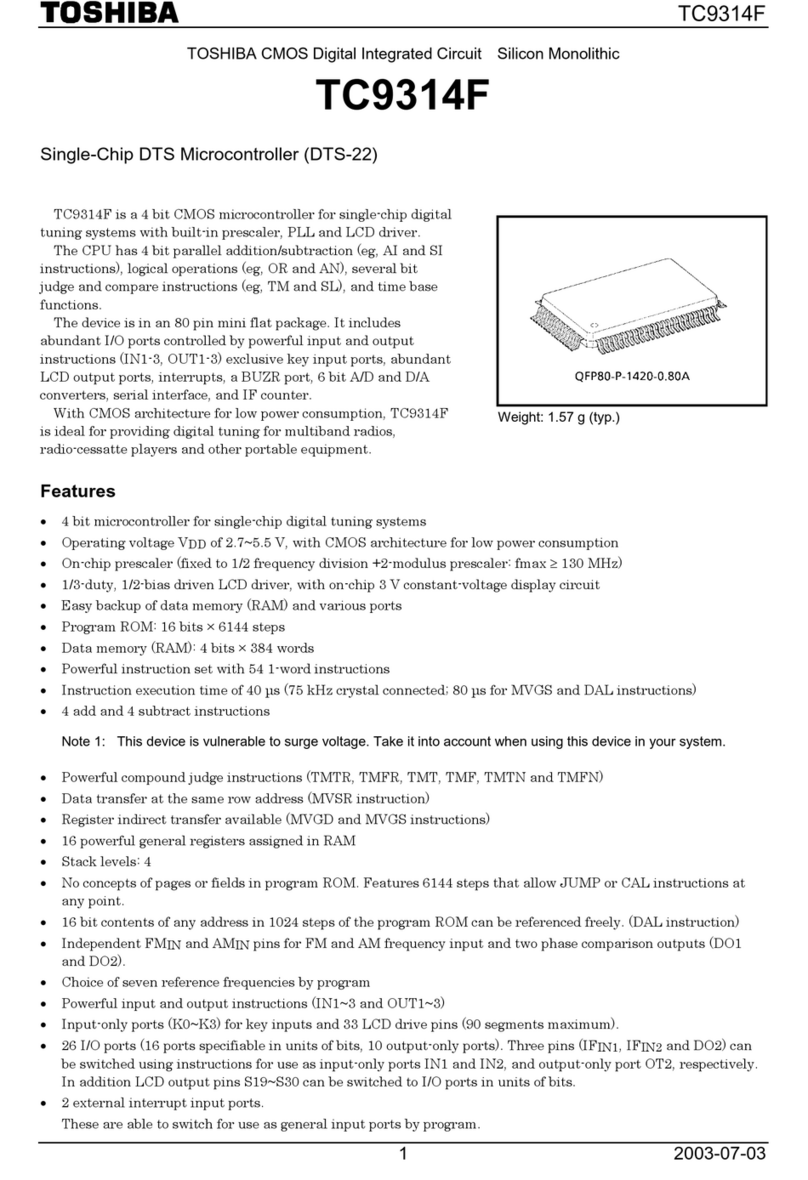
Toshiba
Toshiba TC9314F manual

Texas Instruments
Texas Instruments TLC2543 user guide
Silicon Laboratories
Silicon Laboratories C8051F12X user guide
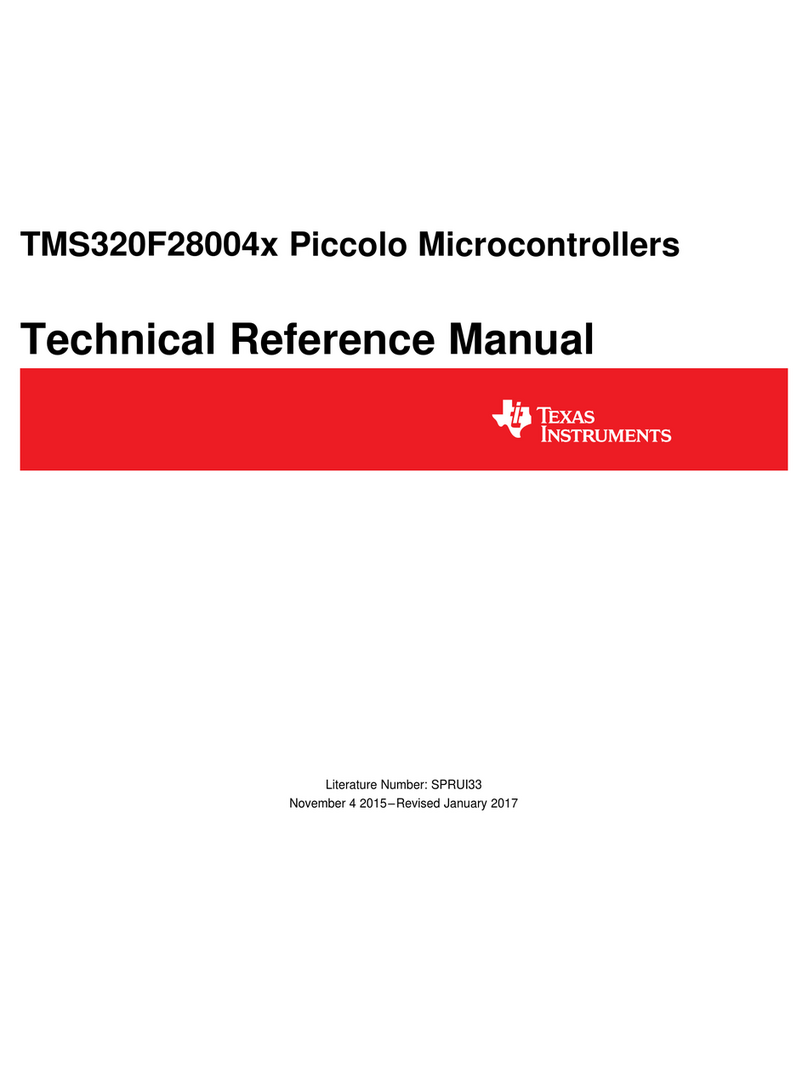
Texas Instruments
Texas Instruments TMS320F28004x Technical reference manual
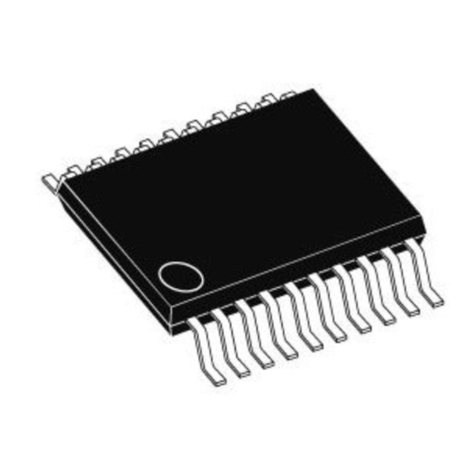
STMicroelectronics
STMicroelectronics STM32F050G6 manual
ON Semiconductor
ON Semiconductor AND9670/D quick start guide
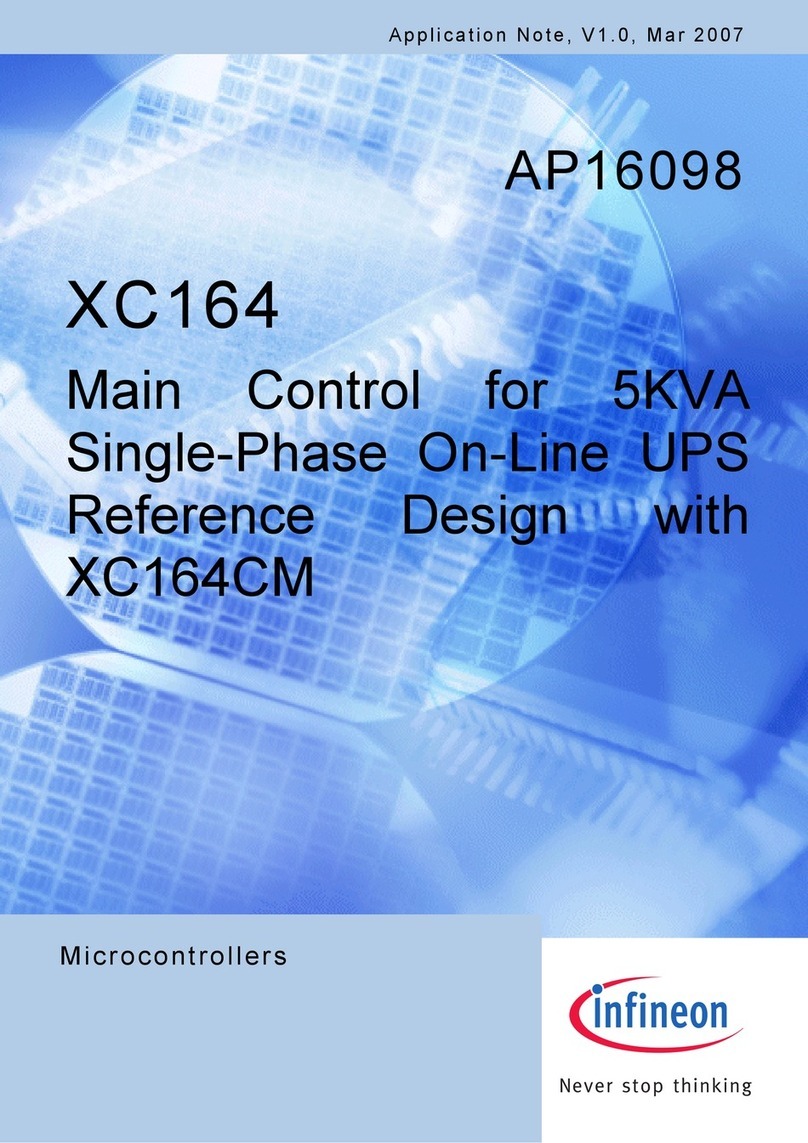
Infineon
Infineon XC164 Series Application note
